The best garden tiles provide hardwearing hardscaping for patios, decking and outdoor paving. Understated tiles will complement your planting and garden accessories. In contrast, you may prefer garden tiles that pop with colour and a maximalist pattern to create a stunning 'outdoor rug'. Decorative tiles pave the way from the indoors to the outside, creating a continuous flow that's harmonious – like following the yellow brick road to your happy place. What's more, stylish accent tiles provide visual interest in the otherwise dreary months of the year. Whatever you want your patchwork to be, let it be unique to you.
Garden tiles are made from a range of materials and we should say right now, they are different from paving slabs and flagstones. Porcelain tiles have lots of benefits, including uniformity, durability, easy installation and more. Available in square or plank shapes, the price can either be per square metre or per individual tile. In terms of the range of finishes, there are realistic wood and marble effect, in addition to stone textures and wonderful intricate patterns. Like applying wallpaper, there's a lot of choice and it's a chance to treat your patio like a canvas.
Best garden tiles at a glance:
• Best encaustic-style porcelain tile: Leinz Grenoble Patterned Porcelain Paving Slabs – View on Walls and Floors
• Best natural stone effect porcelain paving slab: Icaria Plus Ocre Porcelain Paving Slabs – View on Walls and Floors
• Best large porcelain tile: Brazilian Slate Nero Matt Stone Effect Porcelain Outdoor Floor Tile – View on B&Q
Let a chequerboard of black and white diamonds transport you to the tiled pavements of Lisbon, or a tessellating pattern take you to the Alhambra Palace in Spain. What's beneath our feet uplifts us and transforms a space. But if a Roman mosaic isn't your vibe, opt for a subtle woodgrain effect or a surface that mimics stone and slate – so it's neutral without looking too stark. Hardwearing porcelain garden paving slabs provide smooth and pristine flooring. The tiles can be laid in a day and it is a quick, affordable and easy garden upgrade. Always look for encaustic-style tiles, which means the pattern or design has been inlaid rather than printed onto the surface. Encaustic-style tiles are scratch-resistant and more durable.
You can also go for natural stone, slate, granite and sandstone paving slabs as a premium option, but skip to our FAQs to learn more about this, the different garden flooring options and how to lay a patio.
Best garden tiles
Best encaustic-style porcelain tile
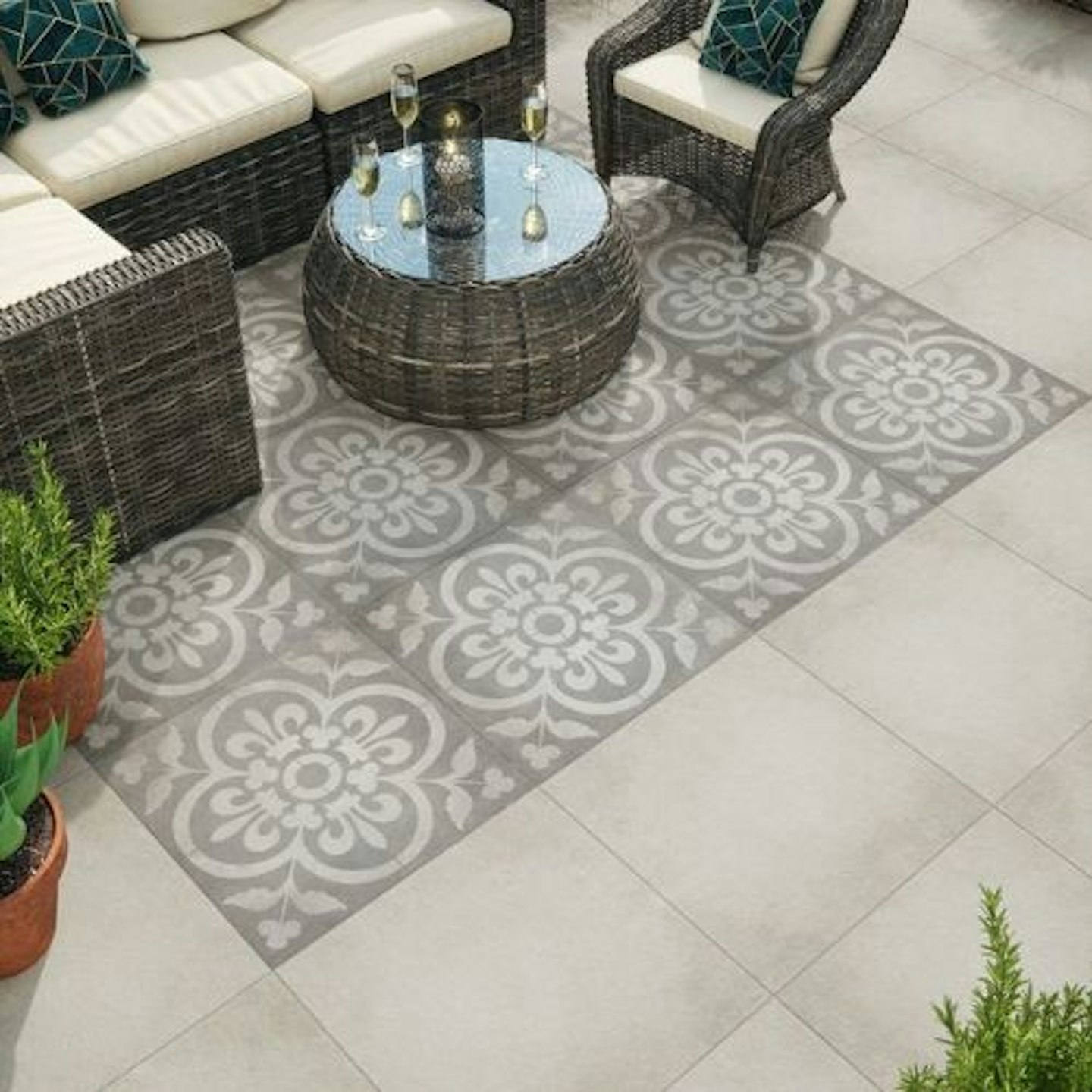
www.wallsandfloors.co.uk
Patterns provide a cohesive look and a strong graphic motif is hard to ignore. These Leinz Grenoble Patterned Porcelain Paving Slabs have a traditional fleur-de-lis pattern that's in a muted colourway so it's outstanding without being obtrusive. With a grey matt finish these porcelain paving slabs bring art deco design to your garden, enabling you to zone a dining or seating area with these particular tiles. Additionally, they are encaustic-style slabs, which means the pigment has been inlaid rather than printed on the surface of the tile. This means they are more durable and scratchproof.
Customer review: "High-quality and great value tiles. We used the Leinz Grenoble Patterned Porcelain to frame our centre planter and create a seating area with the patterned design in between the Clifton Bone Porcelain Paving Slabs the result was a beautiful finish."
Pros
- Elegant
- Looks luxurious
- Durable encaustic-style slabs
Cons
- None
| Size: | 595 x 595 x 20mm |
| Material: | Porcelain |
| Anti slip grade: | R11 |
| Tiles per sqm: | 2.82 |
- Speckled, dark grey hue
- Five face designs available
Best natural stone effect porcelain paving slab
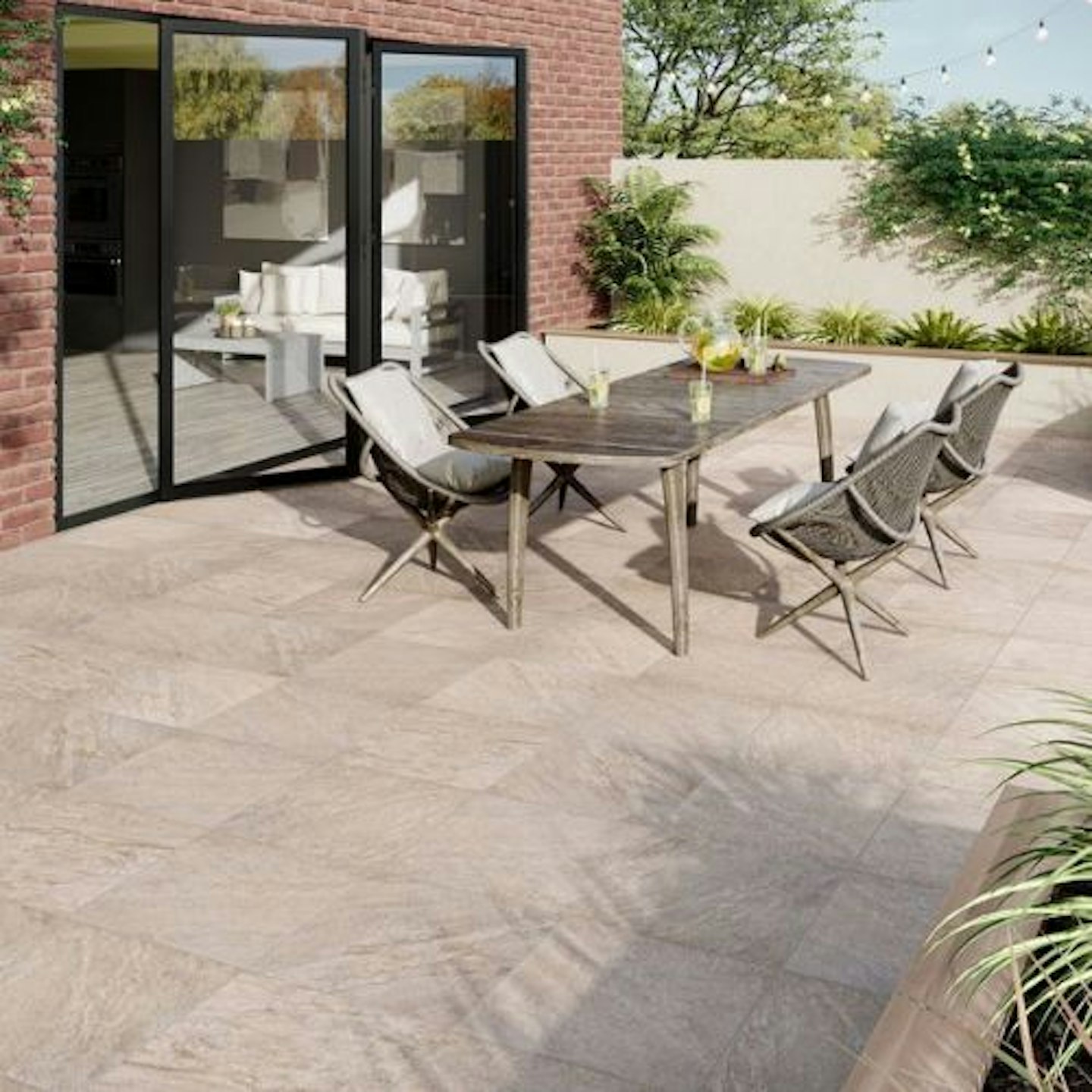
www.wallsandfloors.co.uk
Tap into the hottest trend for natural stone effect flooring with these Icaria Plus Ocre Porcelain Paving Slabs. Increase the feeling of space in your garden with a lighter tile that has a warm stone hue and texture, rather than an intricate pattern. These tiles mimic nature, with a quartzite effect design and directional veining. Yet, they are frost-proof, durable and have a high slip resistance. Porcelain paving is consistent in colour and texture so you have no worries about potential cracked edges.
Customer review: "This is an amazing tile the colours are perfect. Very easy to lay and look fantastic. I would highly recommend this tile and company."
Pros
- Long-lasting
- Frost-proof
- Natural stone look
Cons
- None
| Size: | 595 x 595 x 20mm |
| Material: | Porcelain |
| Anti slip grade: | R11 |
| Tiles per sqm: | 2.82 |
- Quartzite stone effect
- Directional veining for a textured appearance
Best large porcelain tile

www.diy.com
Perfect for creating your al fresco lounge area, the Brazilian Slate Nero Matt Stone Effect Porcelain Outdoor Floor Tile is large and sold individually, so you may only need six to eight tiles to create a zone for entertaining in your garden. With a natural slate effect, this tile looks luxurious. For a sleek and contemporary look, use a block of matt finish tiles as a focal point and add a sofa, coffee table and armchair – just as you would indoors. Keep to a monochrome palette for a super chic look.
Pros
- Larger tiles cover a bigger area
- Looks expensive
- Contemporary style
Cons
- No customer reviews
| Size: | L900 x W600 x D20mm |
| Material: | Porcelain |
| Anti slip grade: | N/A |
| Tiles per sqm: | 0.54/SQM |
- Unglazed
- Slip-resistant surface
Best Victorian-style paving tiles
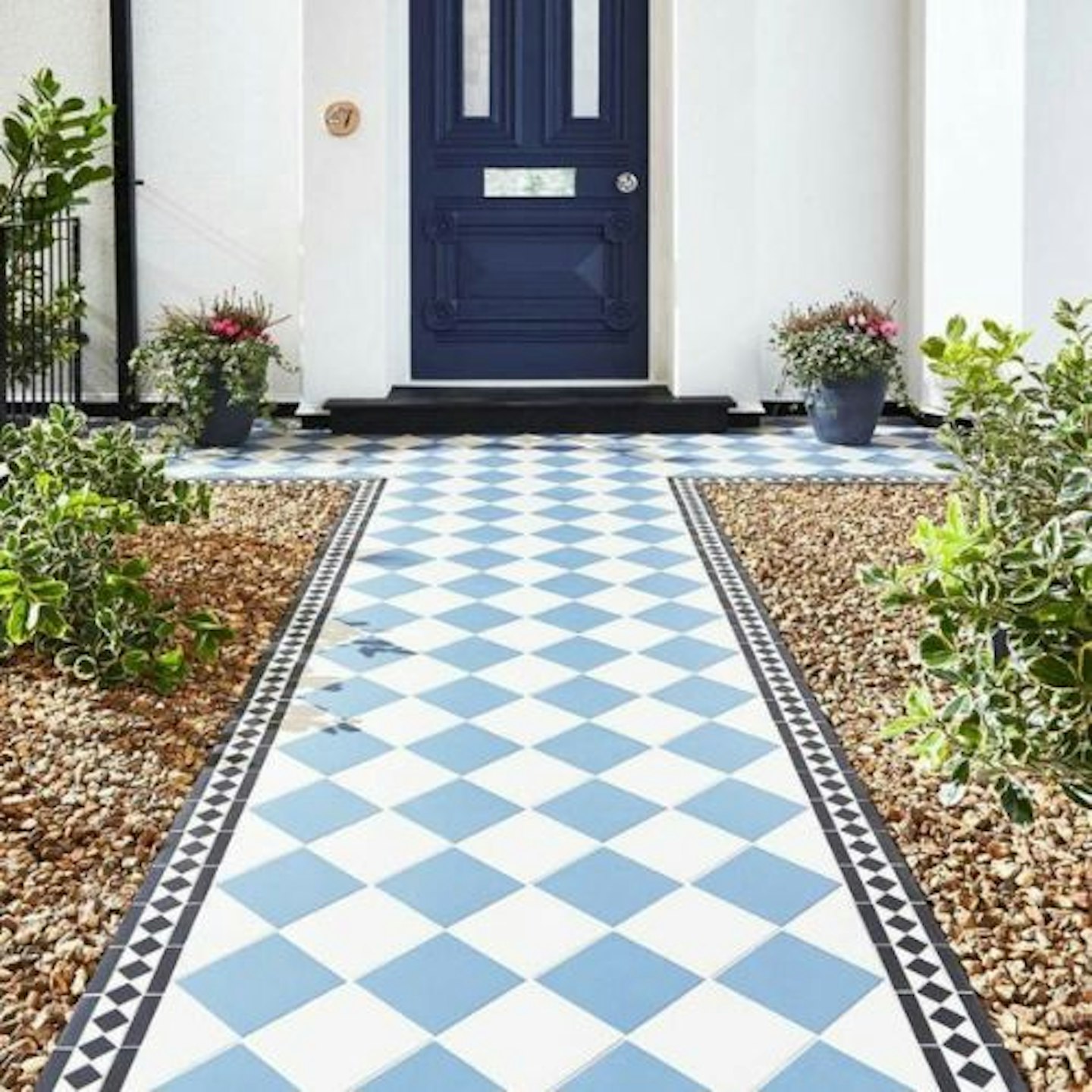
www.wallsandfloors.co.uk
Make a statement pathway or a courtyard centrepiece with a tiled ‘rug’. Victorian-style mosaics surrounded by abundant ferns are right on-trend. With these Cava Victorian White Quarry Tiles, in a matt finish there, is so much scope for extending an outdoor pathway into a grand hallway; whilst enjoying the benefit of durable, non-porous and anti-slip tiles.
Customer review: "Lovely tiles, good quality and price. Worked brilliantly on the path."
Pros
- Get the traditional Victorian path and hallway look
- Lots of colours available
Cons
- Some reviews comment that the white is more cream or off-white
| Size: | 150 x 150 x 8mm |
| Material: | Porcelain |
| Anti slip grade: | R9 |
| Tiles per sqm: | 44.44 |
- Range of colours available
- Use inside and outdoors
Best sandstone effect porcelain tile
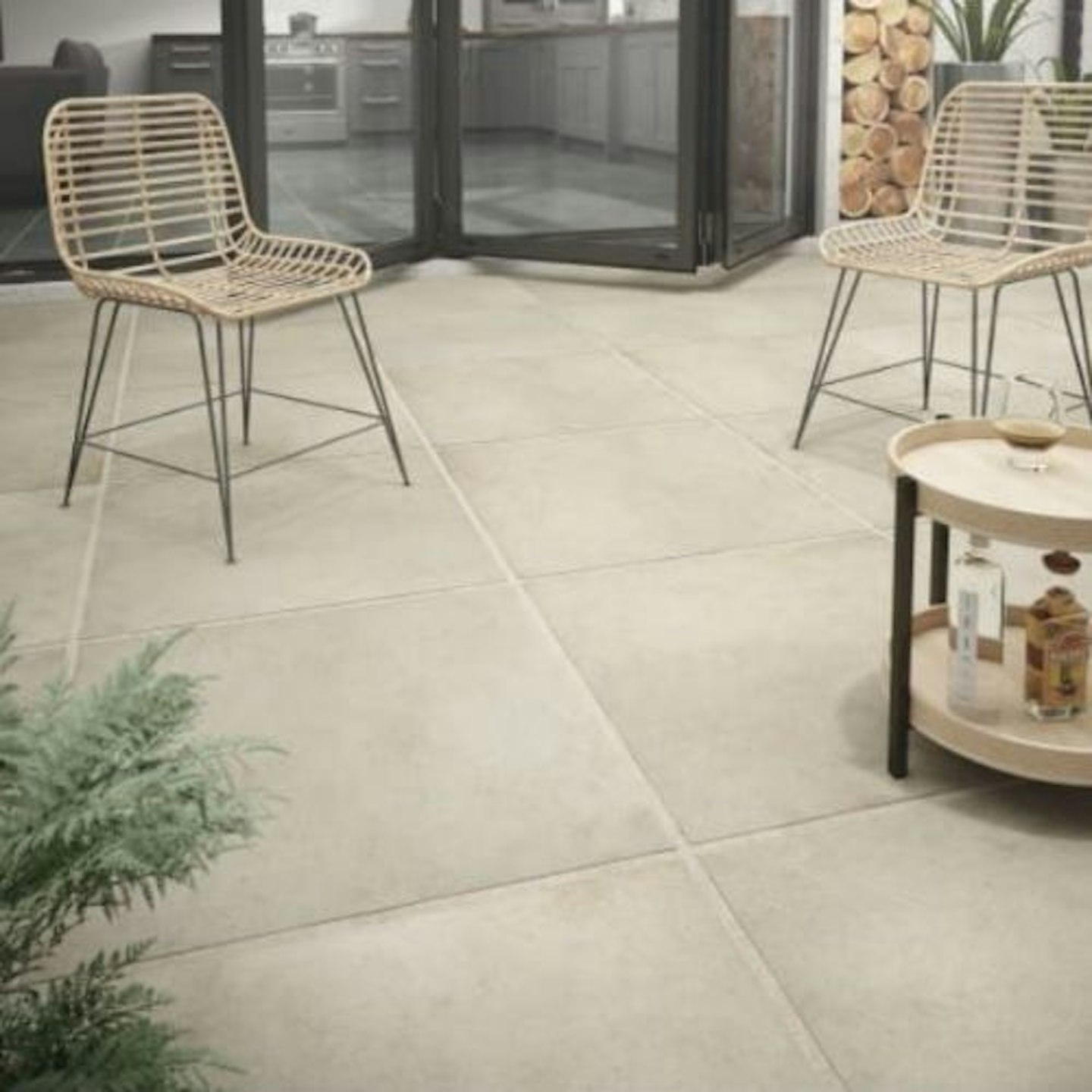
www.wickes.co.uk
By opting for a neutral shade your flooring has an unobtrusive look that allows the rest of your garden to be the spectacle. This Croyde Sand Outdoor Porcelain Paving Tile has a light and airy feel that would be ideal for an open plan kitchen extension that leads out to a paved seating area. Instantly uplifting, the sandstone effect instantly transforms a space. The large tiles will add to the airiness too. Unlike sandstone, which is slippery when wet, these tiles have a grip finish. This pack of two tiles is easy to install and don't require sealing.
Customer review: "Superb quality tiles. They make our conservatory look great."
Pros
- Easy to clean and low maintenance
- Light natural stone finish
- Looks luxurious
Cons
- Sold in a pack of two tiles
| Size: | 610 x 610 x 20mm |
| Material: | Porcelain |
| Anti slip grade: | R11 |
| Tiles per sqm: | N/A |
- Fade, algae and moss resistant
- Frostproof
- Suitable for underfloor heating
Best slate effect porcelain paving
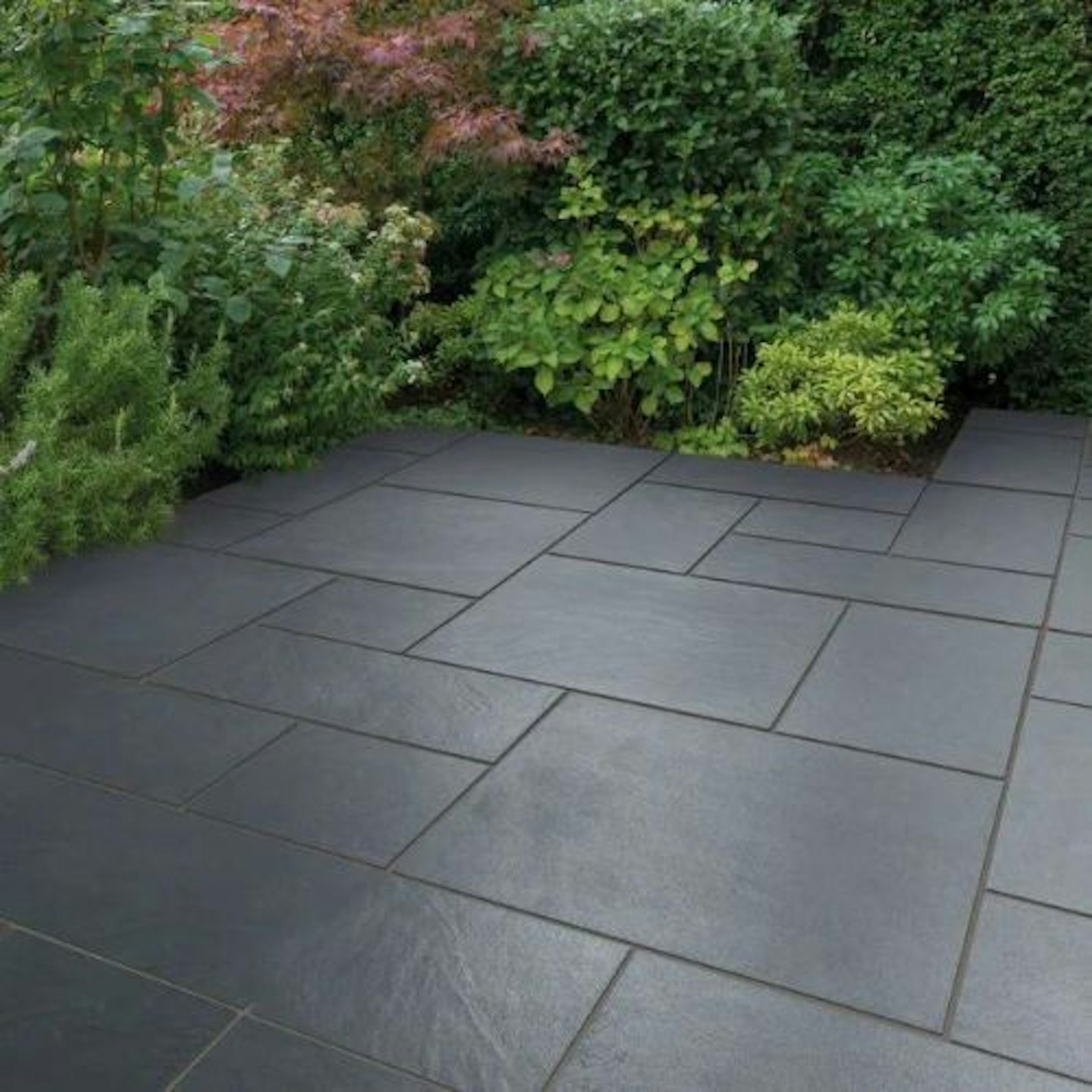
www.simplypaving.com
If you remember Tetris you may enjoy how these Bradstone Vetusto Porcelain Paving in Blue-Black fit together. Don't feel you have to work it out yourself (unless you want to) a plan and instructions are provided. There are three different size tiles that tesselate together to form a chic and modern patio or pathway. These premium quality tiles have the characteristics of aged slate, yet all the durability of porcelain. Additionally, being a dark colour means this outdoor flooring is low maintenance and stylish whatever the weather.
Customer review: "The product was of high quality and good value for money. On delivery, there were spares blocks included. Would not hesitate to use Simply Paving again in the future."
Pros
- Low maintenance slate effect
- Durable and anti-slip
- Natural-looking
Cons
- Be aware there are three different sized tiles in the pack
| Size: | 30 no. 595 x 595mm; 36 no. 595 x 295mm; 12 no. 295 x 295mm |
| Material: | Porcelain |
| Anti slip grade: | R11 |
| Tiles per sqm: | N/A |
- Less than 1% water absorption
- Tiles are also available in individual units
Best patterned porcelain tiles

www.travisperkins.co.uk
Let these enchanting silver glazed porcelain tiles inspire and set the trend for your planting in the garden. Imagine
the silver-green leaves of Artemisia 'Powis Castle' or a vivid purple Verbena popping against these decorative tiles.
Create a zoned area for your pots and leisure seating that's defined by this beautiful pattern and imagine you're somewhere in the Med. These are high quality tiles with all the durability, weather-resistance and slip resistance you'd expect from porcelain tiles.
Pros
- Good slip resistance
- Consistent and uniform
- Simple to install and maintain
Cons
- Individually priced tiles
| Size: | 600 x 600 x 20mm |
| Material: | Porcelain |
| Anti slip grade: | R11 |
| Tiles per sqm: | N/A |
- Algae and moss resistant
- Frost-proof
- Easy to clean
- Uniform thickness
Best wood effect porcelain tile
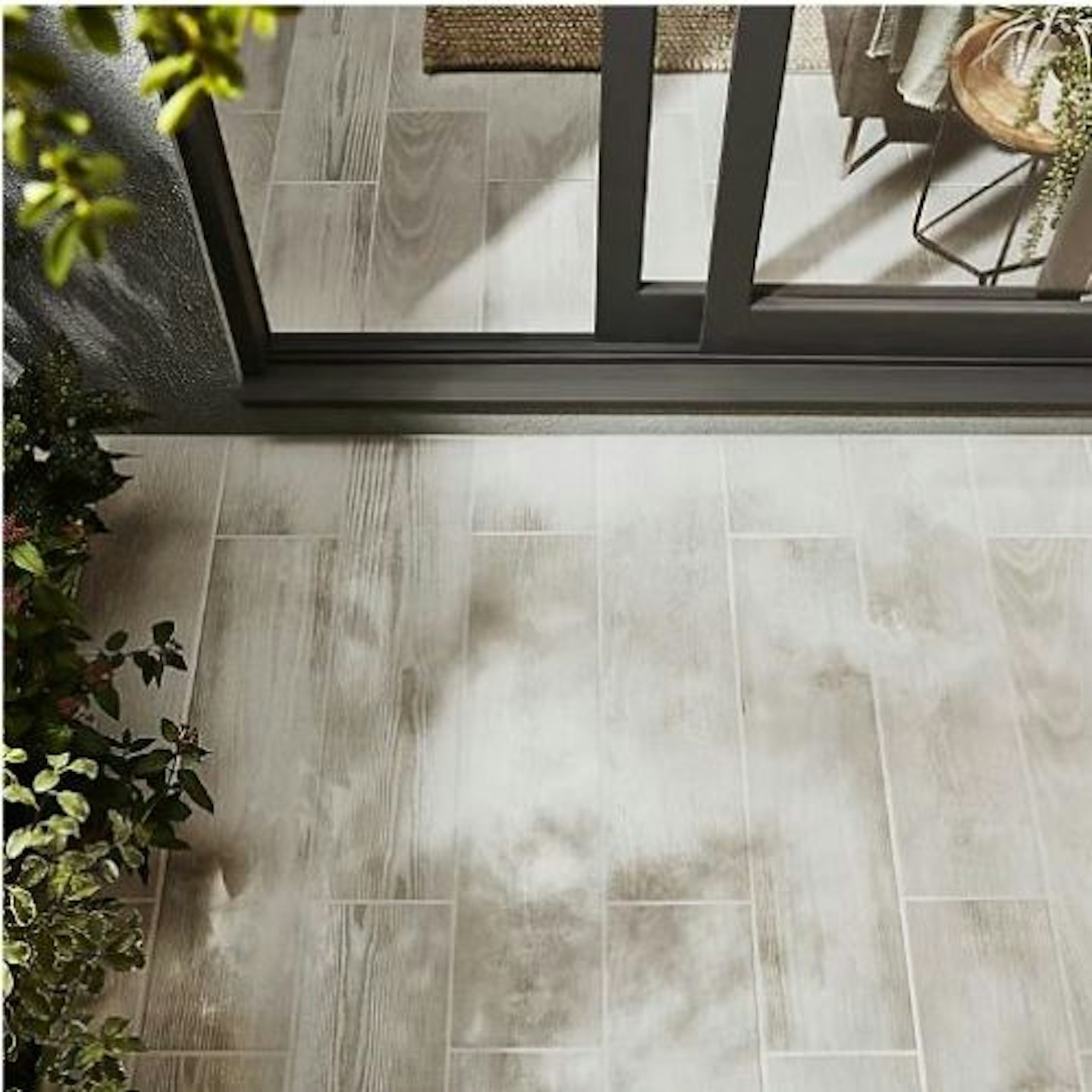
www.diy.com
Take the indoors outside with this pack of eight Pine Wood White Matt Porcelain Outdoor Floor Tile. It's a good value pack of tiles that work out at £25 per sq m. These wood-effect porcelain paving planks could extend from a conservatory onto a patio area. Bi-fold doors would make the garden an extension of indoors and offer lots of versatile space for dining, relaxing and entertaining. Ideal for families, these planks are slip-resistant, low maintenance and frost-proof too. Additionally, porcelain paving is a much cheaper alternative to wooden planks.
Customer review: "Exactly what we wanted, to match our indoor laminate. To have an outdoor area with an indoor vibe. And a great price per sqm."
Pros
- Use inside or outside
- Slip-resistant
- Consistent wood effect
Cons
- Do not use abrasive or corrosive cleaners on these tiles
| Size: | L80 x W20cm |
| Material: | Porcelain |
| Anti slip grade: | Slip-resistant |
| Tiles per sqm: | N/A |
- Frost protected
- Enamelled
Best decking tiles
As an alternative to porcelain tiles, these ingenious interlocking WOLTU WPC Composite Decking Tiles offer a simple solution to creating a paved area. Ideal for a small garden or terrace, simply click these wooden decking tiles together with zero mess or faff. There are four wood colours available to suit your style. For a quick and easy garden update, a little decking goes a long way.
Customer review: "Easy to use, lightweight and robust. Great value for money I would recommend to anyone. Can be used as an impromptu Decking area or to go under plant pots etc. Slot together well and you can change your mind and place them elsewhere."
Pros
- Easy
- Versatile
Cons
- Some reviews comment that they found the tiles difficult to click together
| Size: | 30 x 30cm |
| Material: | 60% wood fibre and 30% plastic |
| Anti slip grade: | N/A |
| Tiles per sqm: | 11 |
- Simple interlocking click system
Best budget garden tiles
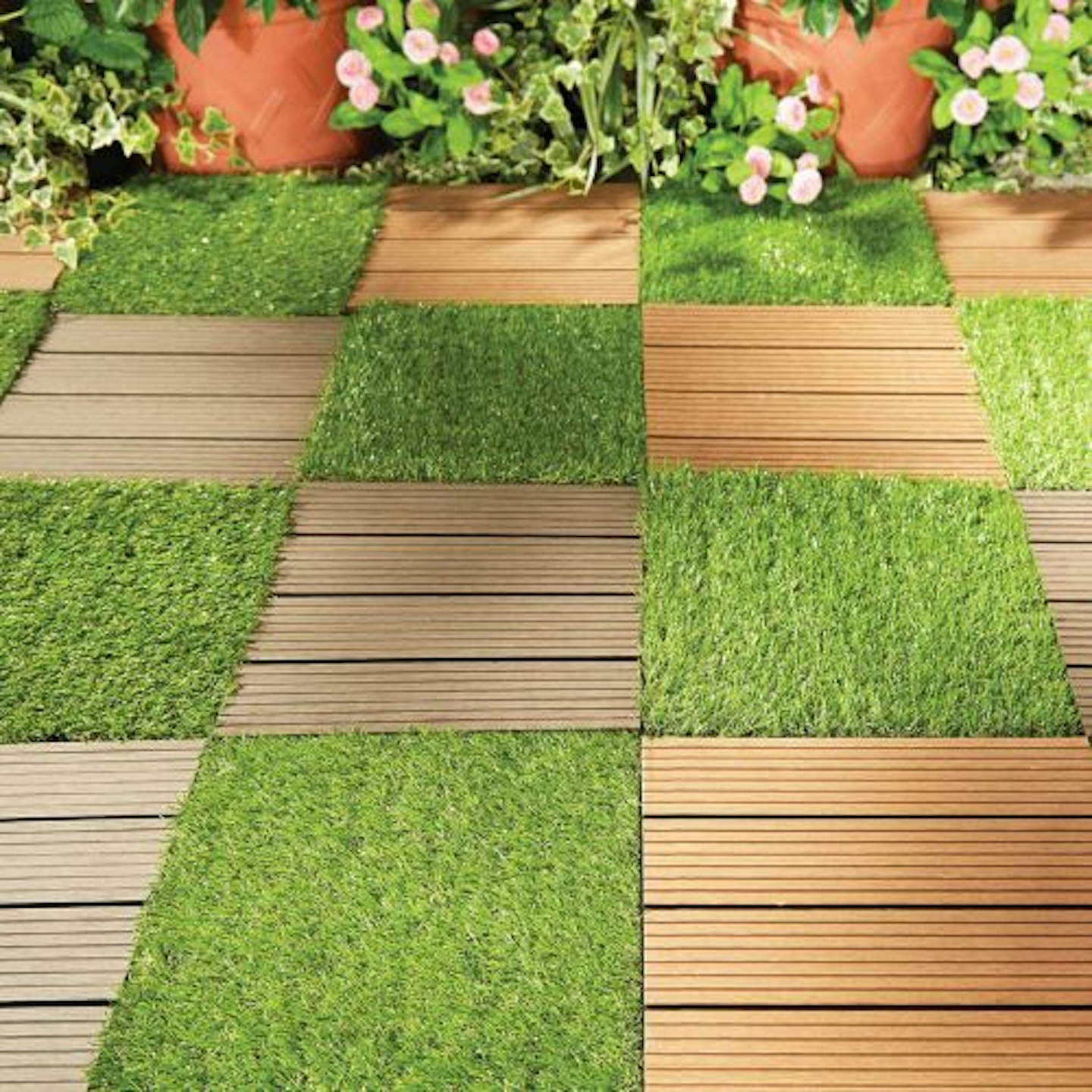
www.coopersofstortford.co.uk
And now for something a little bit different, Grass Tiles that can also interlock with decking tiles and can be easily rearranged thanks to the clip-together plastic base. This gives you versatility and the freedom to rearrange and remove as you wish. Great value for money and a low-cost solution to giving a tired patio a new lease of life. The tiles lay on the ground surface and water can drain through so there are no potential run-off issues.
Pros
- Quick to lay
- Easily rearranged and removed
- Value for money
Cons
- No customer review about this specific product
| Size: | W30 xD2.2 xL30cm |
| Material: | Plastic |
| Anti slip grade: | N/A |
| Tiles per sqm: | N/A |
- Free-draining base
- Simple interlocking system
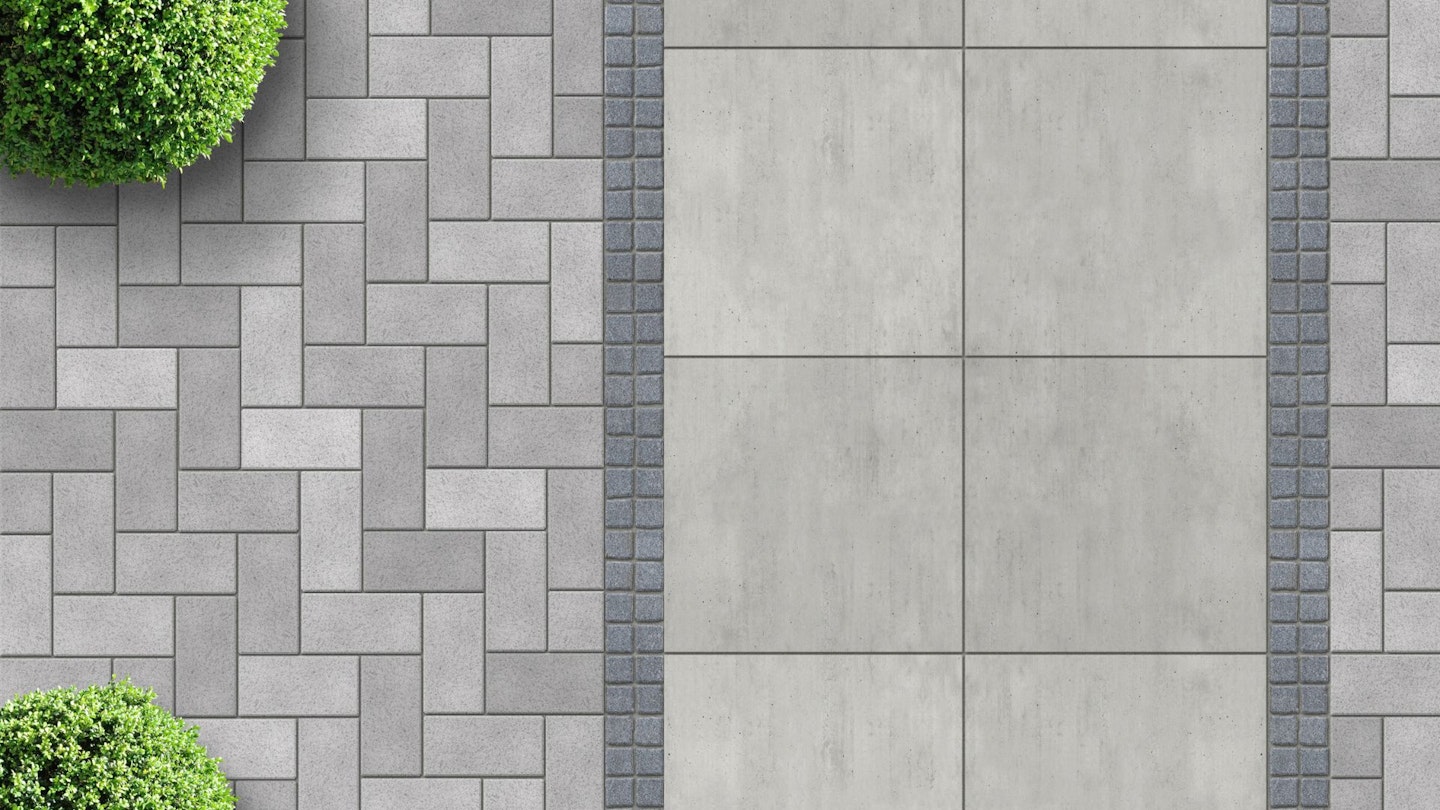
FAQs: Best garden tiles
What are the benefits of porcelain paving tiles?
Porcelain garden tiles are non-porous so they don't absorb moisture. Made from a mixture of sand, clay and feldspar that's fired for a longer time and at a higher temperature than ceramic tiles, porcelain is an extremely durable material. Hardwearing and scratch-proof, its resistance to frost makes it ideal for the Great British climate – no more cracked tiles.
The glaze finish makes porcelain tiles less likely to stain or become slippery. In short, you get all the aesthetic appeal of ceramic, stone or timber with much greater practicality.
As mentioned, natural stone, slate, granite and sandstone paving slabs are a premium option for paving a driveway, path, or patio. However, as beautiful as real stone can be, it is a lot more expensive and is more prone to discolouration than porcelain tiles. But if you want to capture the look of a period property with an authentic herringbone or brick weave path, then opt for traditional heritage stone paving. Each slab is unique, with tumbled edges and irregular shapes, gaining a natural patina over time.
Get Welsh slate in faux form at a fraction of the price of the real natural stone. Or choose a sandstone effect to go around your hot tub and not have to worry about falling in – real sandstone is notoriously slippery. Alternatively, go for a contemporary look with graphite or black tiles for mono chic.
What is a slip rating?
Floor tiles have a slip rating (ramp test) in the product specs. Starting at R9 up to R13, you can see at a glance where they’re safe to use outside. The higher the number following the ‘R' the more anti-slip qualities it has. Porcelain tiles with a resistance of R11 or R12, or any floor tile with a R13 rating, are suitable for use in the garden.
Just to add, interior tiles are generally 6mm thick, while exterior tiles are 20mm in order to withstand the weather and wider temperature range.
How do I maintain my garden tiles?
Porcelain tiles tend to be low maintenance and some have anti-mould properties. But do be sure to hose or pressure wash tiles to remove any grime, moss, mould or mildew. Use a solution of bleach and water. It's best to clean regularly to keep your outdoor flooring looking its best.
How do you prepare to lay a porcelain tile floor?
Porcelain tiles are rigid and an even thickness, which makes them easier to lay than stone or timber decking. If the ground is even they can be bedded directly into soil, gravel and even onto grass. But for longevity, it's best to lay tiles on concrete slabs. Do note that porcelain tiles are heavier and thicker to cut than ceramic tiles.
If you're adding accent tiles to an existing concrete patio it's a good idea to use an adhesive that's a similar colour to the tiles. If you're tiling a large area use cement as it's a cheaper option than adhesive.
Before you purchase any tiles, note the dimensions and create a paper template. You can use this to work out what size your tiled area is going to be, as well as the pattern in which you are going to lay the tiles.
Buy 10 per cent more than you need to allow for wastage in case there are breakages.
You may opt for neat rows that are uniform from corner to corner. In contrast, you may decide on a staggered arrangement of planks. Or, you could frame your tiles with a border of porcelain planks where the edges are cut at a 45 degree angle.
When it comes to grouting, spacers vary between 4mm to 8mm. By having a very narrow space between the tiles you achieve a neater look. But it can also be interesting to create contrast by having different colour grout that's boldly different to the tiles. As Sian O’Neill from Topps Tiles says: “Over recent years, grout colour has become just as important as the choice of tile. It can play a crucial role in achieving a personal look, transforming a tile and creating a very different style or trend.”
If you're daunted by taking on a tiling project, seek out the expertise of a skilled tiler. Find trusted tradespeople in your area on the Tile Association’s listings.
How do I lay a patterned tile patio?
Jill Morgan advises how to lay a one metre squared area patio using patterned tiles:
What you need:
Concrete
Your choice of tiles
Tile cutter
Grout float
Flexible tile adhesive
Notched trowel
5mm tile spacers
Flexible tile grout
Sponge
Soft brush
Knee pads, protective goggles, dust mask and safety gloves
Measure out the area to tile, ensure it is level and fix timber battening around the edges. Mix and pour in the concrete base. Level off the surface by working across the surface from front to back with a length of timber and spirit level. Leave to dry and set for at least six weeks before laying tiles.
Work out how many tiles you will need and arrange them across the concrete base to decide on the best layout and to work out any cuts needed. Using a tile cutter trim any tiles as required.
Mark the position of the central tile or tiles by using lengths of string stretched between two wooden pegs pushed into the ground next to the concrete base. This will be your starting point for tiling.
Clear and sweep the concrete base. Pour the tile adhesive onto the centre of the base and spread out, first using the straight edge of the spreader then repeat with the notched edge to leave even ridges.
Using your string as a guide, lay your first tile, pressing it down and slightly twisting it so it firmly beds in. Repeat with the rest of the tiles using tile spacers between each for equal grout lines. Remove any adhesive from the tiled surface before it hardens.
Mix up and apply the grout using a grout float, working it evenly into the gaps. Wipe off any excess with a sponge before it sets.
If the weather is looking a bit threatening, put plastic sheeting over the newly laid patio to allow it to slowly dry out.
What are my stone garden paving options?
Stonecast is a high-standard concrete that's highly durable and available in a range of styles, textures and colours.
Granite is a naturally formed hard stone with a number of properties that make it an ideal choice for a surface. Granite is resistant to marks and staining, additionally, it's heat-resistant and non-slip.
Natural stone is ideal for a traditional home. Stone from regional quarries varies in texture, colour and size. It's weather-resistant but will need some maintenance, such as pressure washing to remove lichen and grime.
Limestone comes in a lovely range of colours. Limestone is non-slip and can be used around swimming pools and hot tubs.
Sandstone is a sedimentary rock and as such has natural variation in colour and markings. Sandstone does become slippery when it gets wet.
Slate is a durable option for tiles and gives a sleek and contemporary look. It's non-slip and doesn't require much maintenance.
If you're buying a natural stone product you can expect some colour variation. Otherwise, opt for stonecast and porcelain products.
How do I lay a patio with paving slabs?
If you've invested in stone or concrete paving slabs and you're looking for it to be a long-lasting feature of your garden, it's important to get the groundwork right before you begin paving.
Check the area you are going to position your patio with a cable avoidance tool, which you can hire from a tool centre.
Using pegs and string, you can accurately line out the position of the patio. Use a tape measure to check the dimensions and use a large set square to ensure each corner is a perfect 90 degree angle.
Using the string as a guide dig out any turf, plants or stones and remove soil, allowing for a depth of 100mm. This will be the subbase of the patio, plus 25mm of slablayer, plus the depth of your chosen paving slabs.
Add a 50mm layer of hardcore and use a rake to level it out. Compact the hardcore with a wacker plate or tamper, which are available to hire. Please remember to wear the appropriate safety gear when using machinery and tools.
Next, add another 50mm layer of subbase and compact this layer too. These two compacted layers will provide a solid base for your patio. Add a 25mm depth of slablayer, raking the surface for a level layer. Follow the manufacturer's guidance on how much water to add to the slablayer. The water can be applied using a watering can and once again raking the surface to mix.
Wear protective gloves to handle the paving slabs.
The slabs will need to angle on 1/60 gradient to ensure rainwater runs off.
Dampen the underside of the paving slab before laying it on the slablayer. Begin laying at the highest point of the patio. Use a rubber mallet to embed it and use a spirit level to ensure it's level, plus make sure it's square as this slab will be a guide for the rest of the slabs.
Use a space between each slab to ensure a consistent gap. And use a spirit level to check each slab is even, but also allowing for a 1/60 gradient.
Put a plastic tarpaulin over the patio to allow it to slowly dry out. Hold the tarp in place with bricks and planks of wood. Allow to dry for at least 24 hours.
Once the patio is dry, fill in the joints with slablayer using a trowel (pointing). Alternatively, use a mortar mix which is four parts sand to one part cement. Add a little water to the mix to create a damp consistency so it doesn't crack when it sets. Use a semi-stiff broom to brush off any excess mortar or slablayer before it sets.
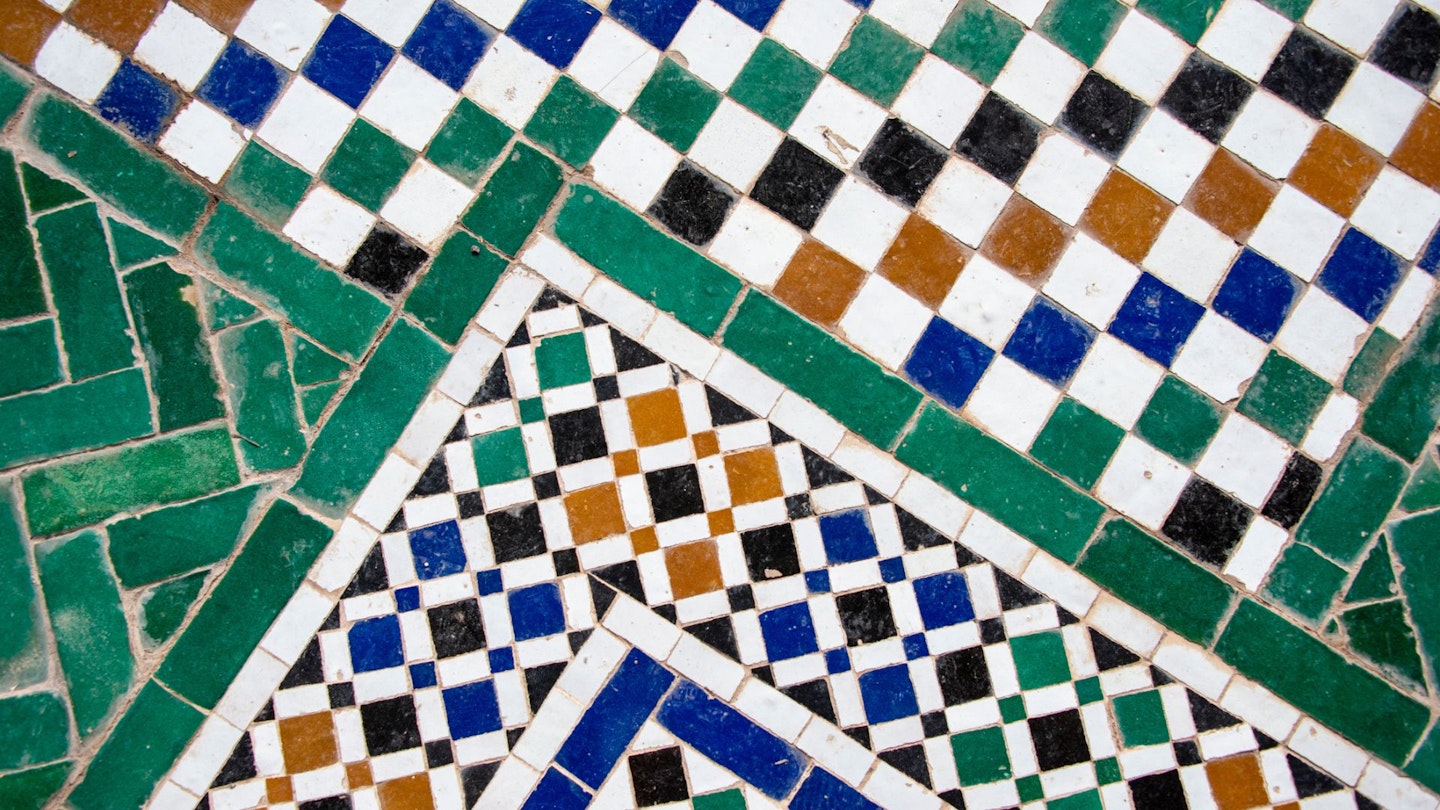
What to read next:
Buyers’ guide to the best composite decking in stylish colours
Discover everything you need to know to make your outside space look fantastic, quickly and easily, with hundreds of simple ideas, designer tricks, affordable products and expert advice with a Modern Gardens Membership. Find out more about the benefits of being a Member now.
Natalie Knowles is a Homes & Garden Product Writer for Modern Gardens, specialising in garden trends. When she's not flexing her mow-how, Natalie is a successful artist and illustrator.


